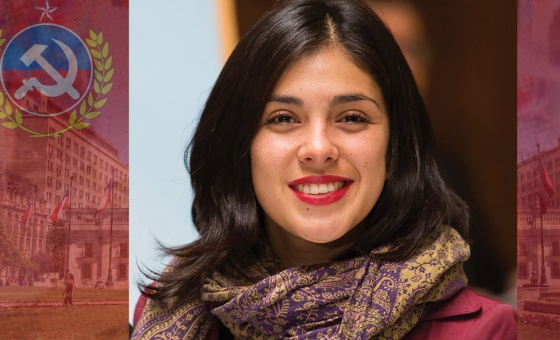This is the last article you can read this month
You can read more article this month
You can read more articles this month
Sorry your limit is up for this month
Reset on:
Please help support the Morning Star by subscribing here
WHAT unites a five-metre leather boot, a cockerel exquisitely crafted from kitchen bones, maps stitched as samplers by convent girls and heart-shaped pin cushions embroidered by lovelorn soldiers?
Nothing, except that all were hand-made and are normally excluded from art museums.
About 200 such diverse and wonderful objects, dating from the 17th to the mid-20th centuries are are on display in Tate Britain’s exhibition British Folk Art, which challenges current definitions of art itself.
We are greeted by a bright yellow wall suspended with oversized black, grey, silver and gold trade signs, including a locksmith’s padlock, a hatter’s top hat, a pensive sun — possibly a pharmacist’s — and a glover’s single glove reaching for the sky.
Carved and gilded by anonymous craftspersons, trade signs were commonly used to identify businesses when illiteracy was rife. To our eyes, the display evokes a 21st-century art installation.
Having pored over intimate paintings, sign writers’ boards and dexterous textile work, the massive ships’ figureheads in the next room spring a surprise.
A mariner, a turbaned Indian and a bold virago lean forward, their resolute gaze protecting sailors and cargoes from the dangers of the sea. Displayed in a sky-blue room, these gaudily painted carvings are more expressive than many a wimpish contemporary statue.
Industrialisation sharpened and institutionalised the high art/low art divide. Rising middle-class patrons welcomed the professionalisation of art, whose elevated content added kudos to their new art collections.
Thus, when the Royal Academy of Art was established in 1769 it excluded needle crafts and “other such baubles.” Marble or oil paint became the ruling class’s materials of choice, works by the “untutored” were relegated to the lowly status of crafts and discussed, if at all, as folklore or social history.
Yet just as folk musicians sang of working people’s lives while chamber orchestras regaled the rich, so working people continued to create visual art. Trade signs and ship’s figureheads were public sculptures for the people by the people.
Whether made by skilled workers for a living or for private pleasure and use, folk art encompasses an impressive variety of materials, skills and techniques. Stitching, applique, embroidery and collage feature large, as do the ingenious use of humble or waste materials. Tailors and textile workers, for example, had access to off-cuts.
Spare time — a rarity for the working class — was available to prisoners, injured soldiers and becalmed sailors. We see sailors’ wool work pictures of ships, their intricate rigging accurately rendered.
A large and meticulously stitched patchwork quilt, with its almost abstract design, was made by a soldier recovering from injuries in the Crimean war as therapy. A French prisoner-of-war from the Napoleonic wars, without access to materials or tools, used broken glass to carve and etch feathers from kitchen bones with which to construct his cockerel.
The exhibition’s curators acknowledge that folk art is difficult to define, as it encompasses or overlaps with “outsider art,” the vernacular, the traditional, the rural, the naive and art of the self-taught.
Rather than attempting a finite definition and an exhausting, comprehensive survey of such diverse tendencies they have rightly opted to present a “proposition” of “intriguing and original” works, grouped according to folk art’s inherently recurring themes — the sea, the countryside, the town, and representational versus abstract formal approaches, to create a focused exhibition which challenges preconceptions about the nebulous topic.
We learn that not all the artists were anonymous. Despite the sexism of the times Mary Linwood (1755-1845) found fame and fortune with her framed needlework copies of famous paintings in which meticulous stitches emulate brush strokes.
Nor were needle crafts the exclusive domain of women.The military tailor James Williams created his elaborate patchwork coverlet with scraps from army uniforms. Biblical scenes — including Noah’s ark — along with contemporary subjects such as the recently built Cefn viaduct and abstract geometric shapes form a complex, sophisticated composition.
A section of samplers shows that some women subverted the norm by depicting detailed maps rather than the usual moral dictums. These showed off their makers’ academic knowledge as well as needlework skills at a time when few women were educated. One even depicted the solar system.
Ironically, folk art has needed to be shown in a high art preserve for it to gain gravitas. Curated in a happy synergy by the artist Jeff McMillan and the scholars Ruth Kenny and Martin Myrone the exhibition combines imaginative flair, clear minded selection and serious scholarship.
Carefully chosen and changing wall colours, subtle lighting and changes of scale reflect differing content, so helping the visitor to respond to such varied and sometimes unfamiliar works.
Serious issues raised by the genre are introduced with deftness, leaving the visitor stimulated rather than bludgeoned and hoping for further exposure for this vibrant people’s art.
British Folk Art runs at Tate Britain, Millbank, London SW1 until August 31. Box office: (020) 7887-8888.










